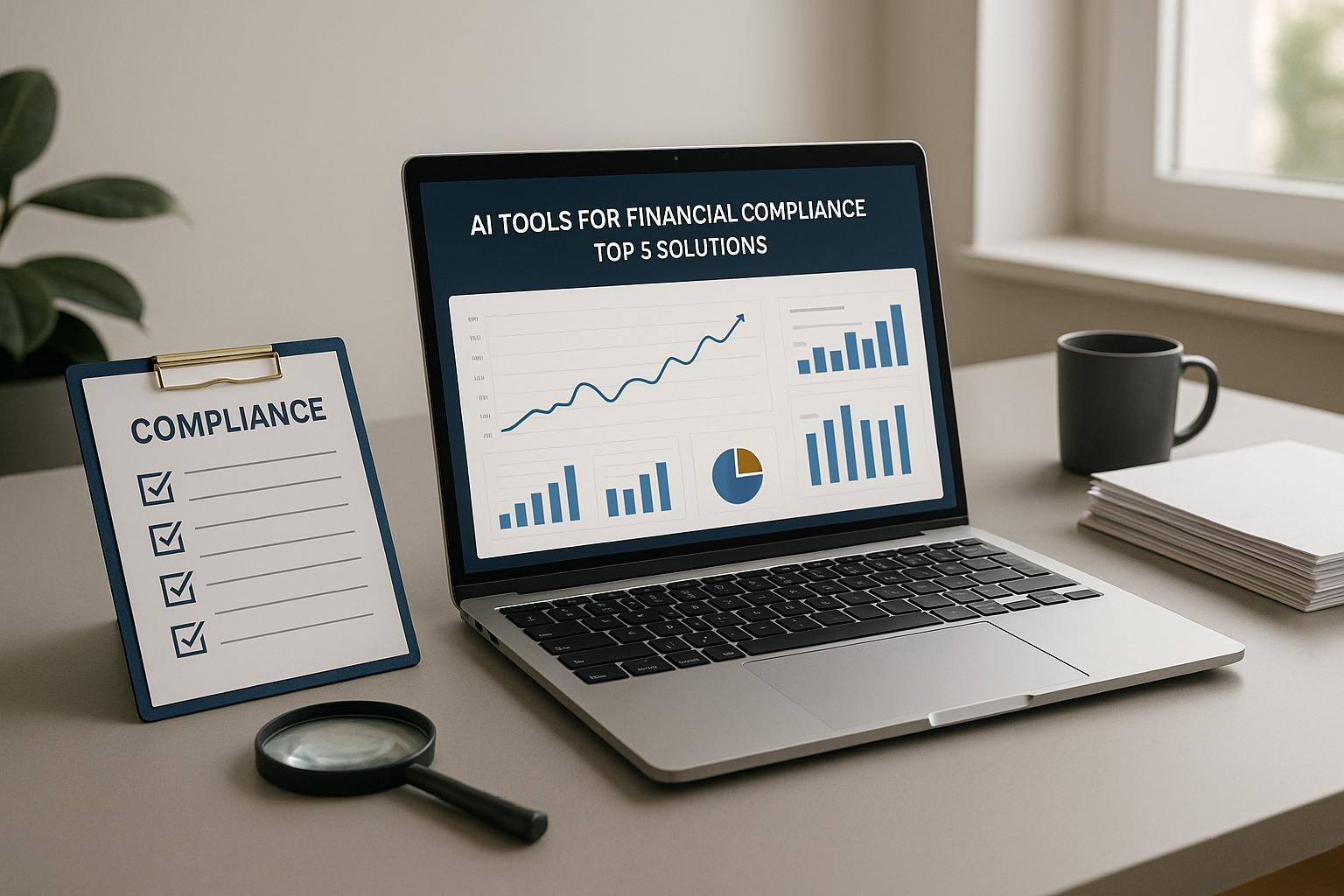
AI Tools for Financial Compliance: Top 5 Solutions
AI is transforming financial compliance by automating tasks, reducing false positives, and streamlining regulatory processes. Here are five top AI solutions to help financial institutions stay compliant while cutting costs and improving efficiency:
- Compliance.ai: Real-time regulatory monitoring with tailored alerts and seamless integration. Reduces document reviews from 25,537 to 585 annually.
- Kount (by Equifax): Fraud prevention and AML tools with advanced analytics. Cuts chargeback labor by 84% and boosts ROI by 914%.
- SAS Compliance Solutions: AI-driven analytics for fraud detection and AML with up to 93% fewer false positives.
- Hawk:AI: Real-time transaction monitoring and AML systems with 70% fewer false positives.
- Leo RegTech: AI assistant for compliance queries, AML screening, and training tools, reducing false positives by 60%.
Quick Comparison
| Solution | Core Features | Pricing Range | Key Strengths |
|---|---|---|---|
| Compliance.ai | Regulatory alerts, document automation | $100,000–$800,000 annually | Simplifies compliance tracking |
| Kount | Fraud detection, AML tools | $150,000–$500,000 annually | Advanced fraud prevention |
| SAS Solutions | Predictive analytics, AML monitoring | $500,000–$2M+ annually | Deep analytics, fewer false positives |
| Hawk:AI | Real-time monitoring, AML overlay | $200,000–$600,000 annually | Explainable AI, scalable integration |
| Leo RegTech | AI assistant, AML, compliance training | $75,000–$400,000 annually | Cost-effective, modular design |
These tools are helping institutions adapt to evolving regulations, reduce manual work, and improve compliance accuracy. Read on to explore their features, pricing, and benefits in detail.
1. Compliance.ai
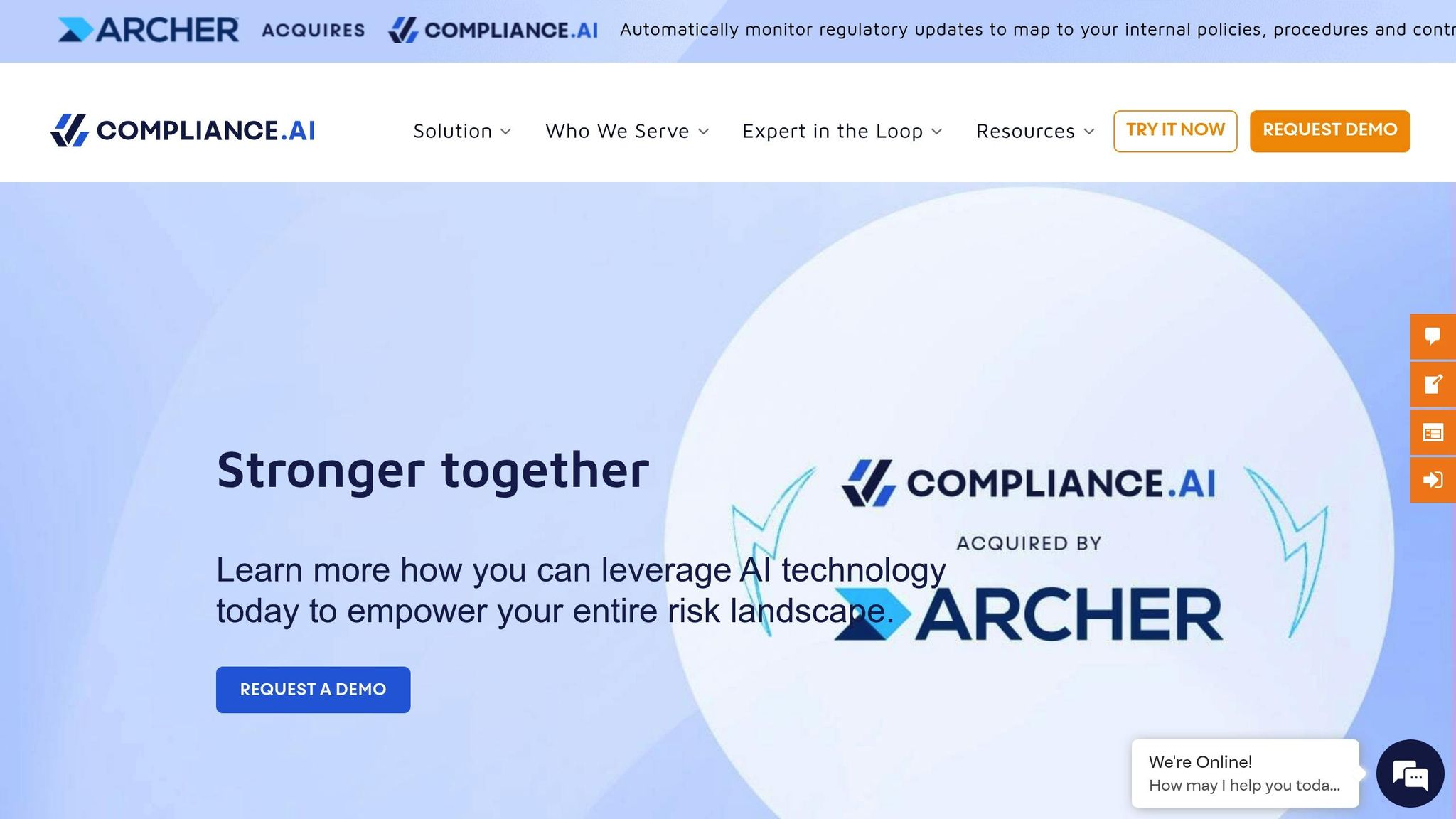
Compliance.ai transforms the way organizations handle compliance monitoring. As a regulatory intelligence platform, it uses advanced machine learning to analyze regulations and help teams stay ahead of changes. This enables real-time alerts and seamless integrations that simplify compliance processes.
Real-time monitoring and alerts
The platform delivers tailored alerts on regulatory updates, allowing users to customize their preferences to track specific agencies, topics, or requirements across various jurisdictions. It even monitors multiple versions of upcoming regulations, giving institutions a heads-up on potential changes. With unlimited alerts, users are notified immediately about updates in regulatory affairs.
"Compliance.ai's platform is incredibly helpful for contextualizing the vast amount of daily regulatory updates into actionable insights, and customizing my content feed, so I have focused and timely information on all the regulatory changes relevant to my business." - Ileana Falticeni, Chief Legal Officer at Quantcast
Another standout feature is its ability to tag and organize documents automatically, creating a searchable regulatory library. This automation eliminates irrelevant documents, significantly reducing the workload for compliance teams. For example, Compliance.ai's filtering capabilities helped teams cut down the number of documents reviewed annually from 25,537 to just 585.
Integration with financial platforms
Compliance.ai integrates seamlessly with GRC systems, workflow tools, automation platforms, and content management systems through its Service Connector. It supports RSS/SFTP data ingestion and API integrations, enabling users to build custom workflows and topic-specific searches. Tailored searches and alerts ensure curated regulatory content is delivered directly to users' platforms. Additionally, workflows within Compliance.ai can automatically send documents and metadata to third-party systems, streamlining compliance tasks.
Pricing structure and scalability
The platform is designed to grow with your needs, offering tiered, client-specific pricing. Its architecture ensures scalability by delivering information from a single, reliable source, eliminating the need to pull content from multiple places.
"Most solutions in the market today are not scalable and still rely on a pull of regulatory content across a multitude of sources, rather than a 'push' of information from a single, reliable source. This is the key value Compliance.ai delivers for banks." - Richard Dupree, SVP, IHC Group Operational Risk Manager - Bank of the West
2. Kount (by Equifax)
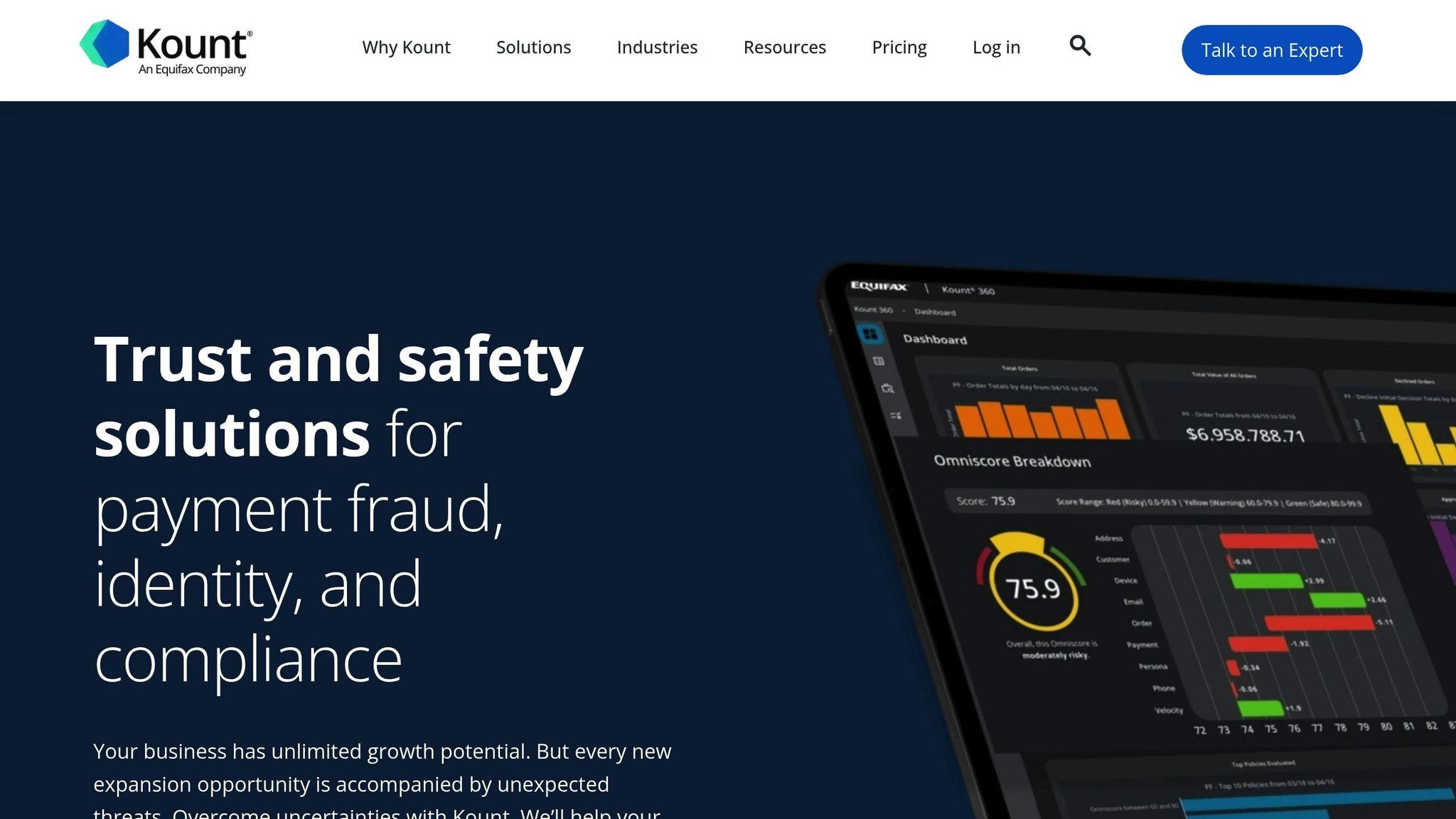
Kount is a fraud prevention and compliance platform powered by Equifax's expertise in regulatory requirements and trust-based technology. It’s tailored to help financial institutions navigate complex regulations while maintaining opportunities for growth.
Real-time Monitoring and Alerts
Kount provides real-time alerts to meet know your customer (KYC) standards and continuously monitors customer records on an hourly or daily basis for changes in risk profiles. This constant vigilance is crucial, especially as global e-commerce losses to digital payment fraud hit $41 billion in 2022. By analyzing hundreds of data points, Kount creates detailed personal profiles to identify unusual patterns or anomalies that could indicate fraud or money laundering. These alerts work alongside its fraud detection tools to help businesses stay ahead of evolving threats.
Fraud Detection and AML Capabilities
Beyond real-time alerts, Kount’s fraud detection system uses advanced analytics to quickly spot anomalies. With its proprietary data, machine learning, and automation, the platform simplifies compliance with AML (anti-money laundering) and KYC regulations. Kount handles tasks like AML screening and chargeback management while automatically assessing customer risk, screening transactions, and spotting suspicious activity. It even verifies identities and detects synthetic IDs right from the first interaction.
Clients have reported impressive results: a 117% boost in chargeback win rates, an 84% reduction in labor hours for managing chargebacks, and an average return on investment of 914%.
"Kount allows us to continue to serve the customer to the best of our ability without having to slow things down, without having to say no to the customer." - Chad Funk, Fraud Specialist
The platform also includes global watchlist screening, portfolio monitoring through regulatory reporting, and customer due diligence supported by analyst reviews. Using both supervised and unsupervised machine learning, Kount delivers precise compliance decisions and deeper insights.
Integration with Financial Platforms
Kount 360 streamlines integration with its unified API schema, minimizing technical challenges. The platform connects directly with major e-commerce systems and integrates easily into existing workflows. With features like sandbox testing, Kount ensures smooth data flow while meeting industry regulations. For instance, ConnexPay integrated Kount to enable real-time fraud prevention, allowing them to analyze payment trends and make smarter decisions. Additionally, Kount complies with PCI-DSS level 1 standards and adheres to GDPR, CCPA, and HIPAA regulations, ensuring secure and compliant integrations. Financial institutions can further refine fraud detection using custom data fields, counter functions, and Kount’s extensive dataset.
Pricing Structure and Scalability
Kount offers cost efficiency and operational savings, with clients reporting an average return on investment of 914%.
"The combination of Kount and Equifax will help more businesses around the world to better protect their digital presence and their customers against emerging threats while offering a frictionless customer experience." - Sid Singh, President of United States Information Solutions at Equifax
Designed for high-volume environments, Kount can process hundreds of transactions per second. Its flexible integration options make it scalable for businesses of all sizes. Financial institutions can also combine multiple Kount solutions to enhance protection and simplify compliance management.
3. SAS Compliance Solutions
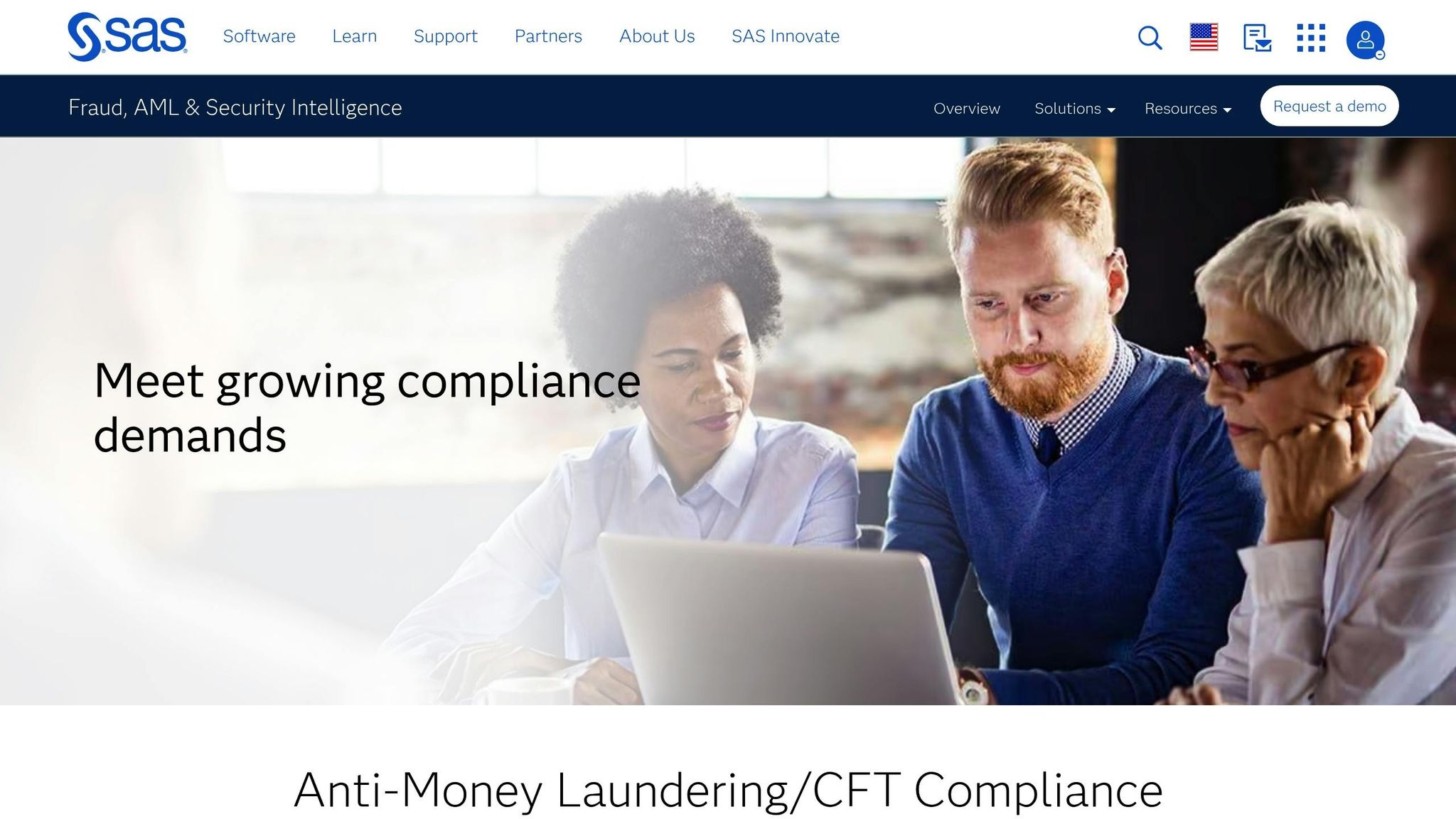
SAS Compliance Solutions provides a robust system for tackling regulatory challenges, with a focus on real-time monitoring, fraud detection, and flexible integration. By leveraging AI and advanced analytics, SAS helps financial institutions navigate complex regulations while detecting financial crimes throughout the customer lifecycle.
Real-time Monitoring and Alerts
SAS takes real-time monitoring to the next level with its Real-Time Watchlist Screening, which can boost matching speeds by up to 100 times. This system uses AI-driven data matching and real-time decision-making to manage watchlist screenings in both batch and live environments. By deploying advanced fuzzy matching algorithms tailored to individual business needs, it ensures precise results while minimizing false positives. The platform evaluates a range of data points - such as names, gender, birth details, identifiers, and geolocation - using AI-enabled meta-matching and scoring techniques.
For example, Orange Bank implemented SAS's real-time sanctions screening in late 2022, achieving a 65% reduction in false positives.
"We wanted a solution that is innovative, modern and robust, and allows us to adapt to the evolution of money laundering risks and terrorism financing – all while having internal control over the algorithms and scenarios. SAS met both expectations for us."
– Véronique McCarrol, Deputy CEO, Orange Bank
Fraud Detection and AML Capabilities
SAS goes beyond traditional rule-based systems with its AI-driven analytics to detect sophisticated fraud schemes. The platform automates manual investigations, significantly improving regulatory report conversion rates - by three to five times compared to standard methods. It also integrates perpetual Know Your Customer (KYC) practices via Customer Due Diligence (CDD) and Enhanced Due Diligence (EDD) tools, offering flexibility through a low-code/no-code interface that allows customization without requiring deep technical expertise.
The system's AI optimizations dramatically reduce false positive alerts - up to 93% fewer false positives - and streamline investigations by summarizing suspicious activity at the client or counterparty level. Techcombank, for instance, saw fraud detection times plummet to just seconds after adopting SAS solutions.
"SAS and Neterium provide the bank's analysts a 360-degree view of the AML risk of our clients in one solution: monitoring of the transaction, risk classification of the client, filtering of the prospects and clients, and screening of the transactions."
– Monika Cwiertnia, Director of Compliance and Financial Crime, Orange Bank
Integration with Financial Platforms
SAS places a strong emphasis on integration while offering a modular design for flexibility. Its cloud-native architecture allows for quick deployment and scalability. The platform unifies several essential functions - data integration, quality control, entity resolution, automated monitoring, AI-driven insights, investigation management, and reporting - into one streamlined system to handle the entire compliance process. Additionally, it integrates seamlessly with commercial watchlists, using advanced algorithms for holistic and semantic matching.
Pricing Structure and Scalability
SAS doesn't publicly share detailed pricing information, but its cloud-native design supports flexible deployment tailored to an institution’s needs. The platform’s ability to reduce false positives by up to 93% and improve regulatory report conversions by three to five times can lead to substantial cost savings. Its low-code interface also simplifies implementation and ongoing system maintenance, making it easier for financial institutions to stay agile as regulations change.
4. Hawk:AI
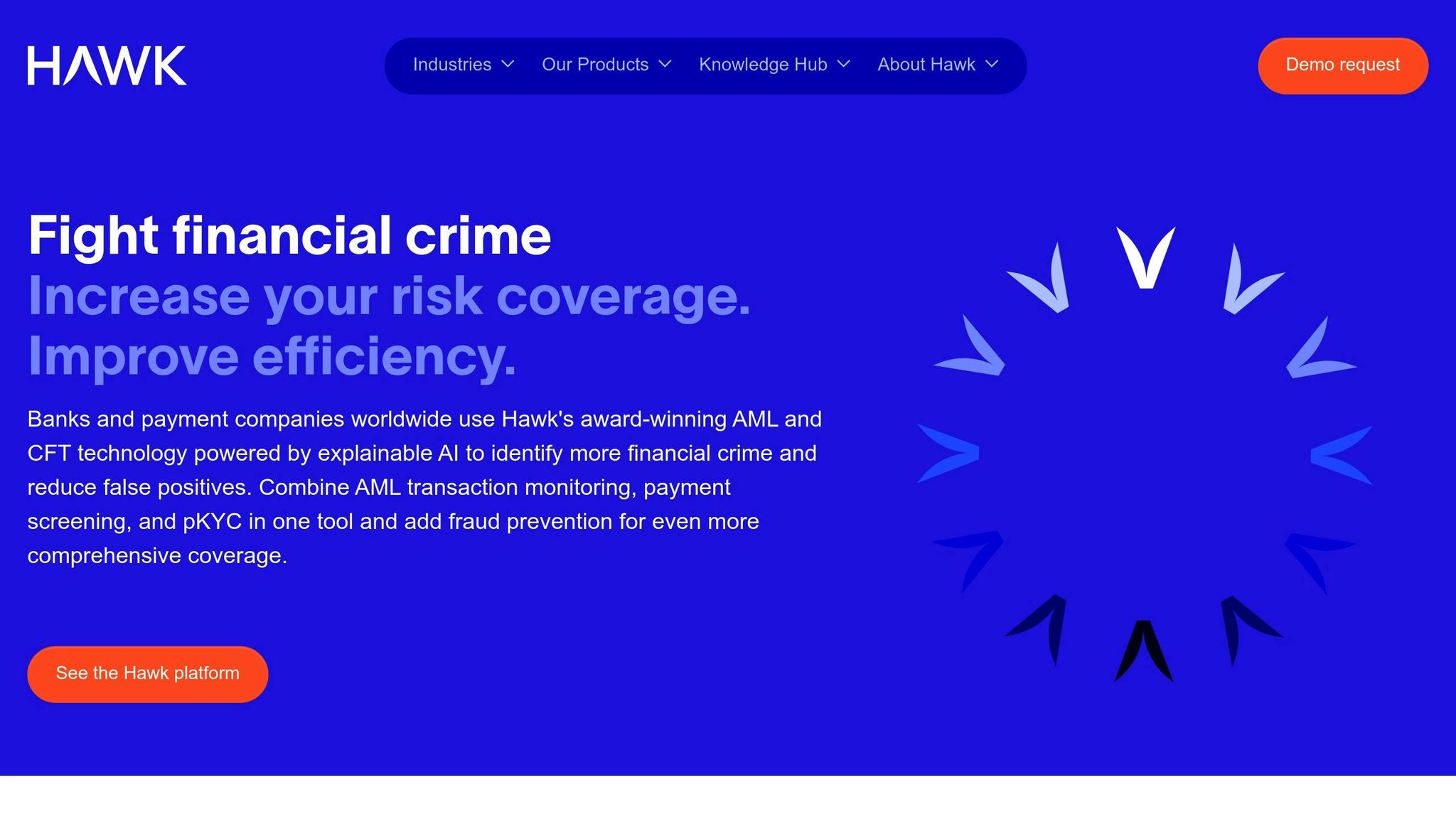
Hawk:AI stands out for its ability to deliver real-time compliance by blending traditional rule-based systems with advanced AI. This approach has earned it recognition, including an award from Chartis for its real-time transaction monitoring capabilities.
Real-time Monitoring and Alerts
Hawk:AI shifts the focus from traditional after-the-fact anti-money laundering (AML) methods to real-time monitoring. The platform keeps a constant watch on end-user transactions across all channels, sending immediate alerts when suspicious activity arises. This proactive approach helps financial institutions stay compliant with regulations and avoid penalties.
The platform's AI-powered anomaly detection goes beyond standard rule-based systems, uncovering patterns that might otherwise be missed. This capability strengthens compliance monitoring and lays the foundation for Hawk's advanced fraud detection system.
"Hawk has clearly demonstrated its ability to deliver real-time transaction monitoring in a sector where immediate detection can have a significant impact. In AML, an area that has traditionally been after-the-fact, many financial institutions are now looking at real-time detection."
– Nick Vitchev, Research Director at Chartis
Fraud Detection and AML Capabilities
Hawk:AI enhances risk detection by 3–5 times, slashes false positives by 70%, and unifies AML monitoring, payment screening, and perpetual Know Your Customer (pKYC) processes into a single tool. Its detection methods - anomaly detection, pattern recognition, and alert prioritization - streamline workloads and improve efficiency.
ONE, an international payment services provider, adopted Hawk's AML transaction monitoring and payment screening solution in January 2025. The results were immediate and impactful.
"Hawk has helped us up-level our AML program. We've already seen transformative process efficiencies that improve our operations and give us scope for further growth."
– Anastasia Chernysh, MLRO at ONE
For institutions seeking to enhance existing systems without a full overhaul, Hawk's AML AI Overlay offers over 85% prediction accuracy and reduces false positives to under 15%. When paired with optimized rule sets, it can cut workloads by 50%.
Integration with Financial Platforms
Hawk:AI is built for seamless integration, using a modern API to connect with existing systems. Financial institutions can either overlay Hawk on current setups or fully replace outdated solutions. The AML AI Overlay provides a cost-effective way to harness AI without requiring expensive system replacements. Additionally, the integration layer ensures smooth data flow within existing case management systems, maintaining operational efficiency.
ONE’s experience highlights these capabilities. The platform was implemented within weeks, offering a smooth transition. It also enabled the institution to apply custom risk factors and thresholds for precise AML transaction monitoring.
"The Hawk team has been a breath of fresh air. They made every step of the implementation process straightforward and simple."
– Anastasia Chernysh
Pricing Structure and Scalability
While Hawk:AI does not disclose detailed pricing publicly, its modular design allows institutions to combine AML and fraud solutions under one contract, potentially reducing overall compliance costs. By cutting false positives by 70%, the platform significantly lowers analyst workloads and associated expenses. Its no-code interface for rule customization further reduces implementation time and ongoing maintenance costs. This scalable and flexible structure makes Hawk:AI a cost-efficient solution for compliance teams of all sizes.
"AML is poised to become more real-time in the coming years... To meet this shift, banks will rely on greater levels of precision and minimal false positives - both attainable through AI and high thresholds. We're proud to be recognized as leading the way in giving financial institutions the real-time capabilities needed to achieve this."
– Tobias Schweiger, CEO at Hawk
sbb-itb-ef0082b
5. Leo RegTech
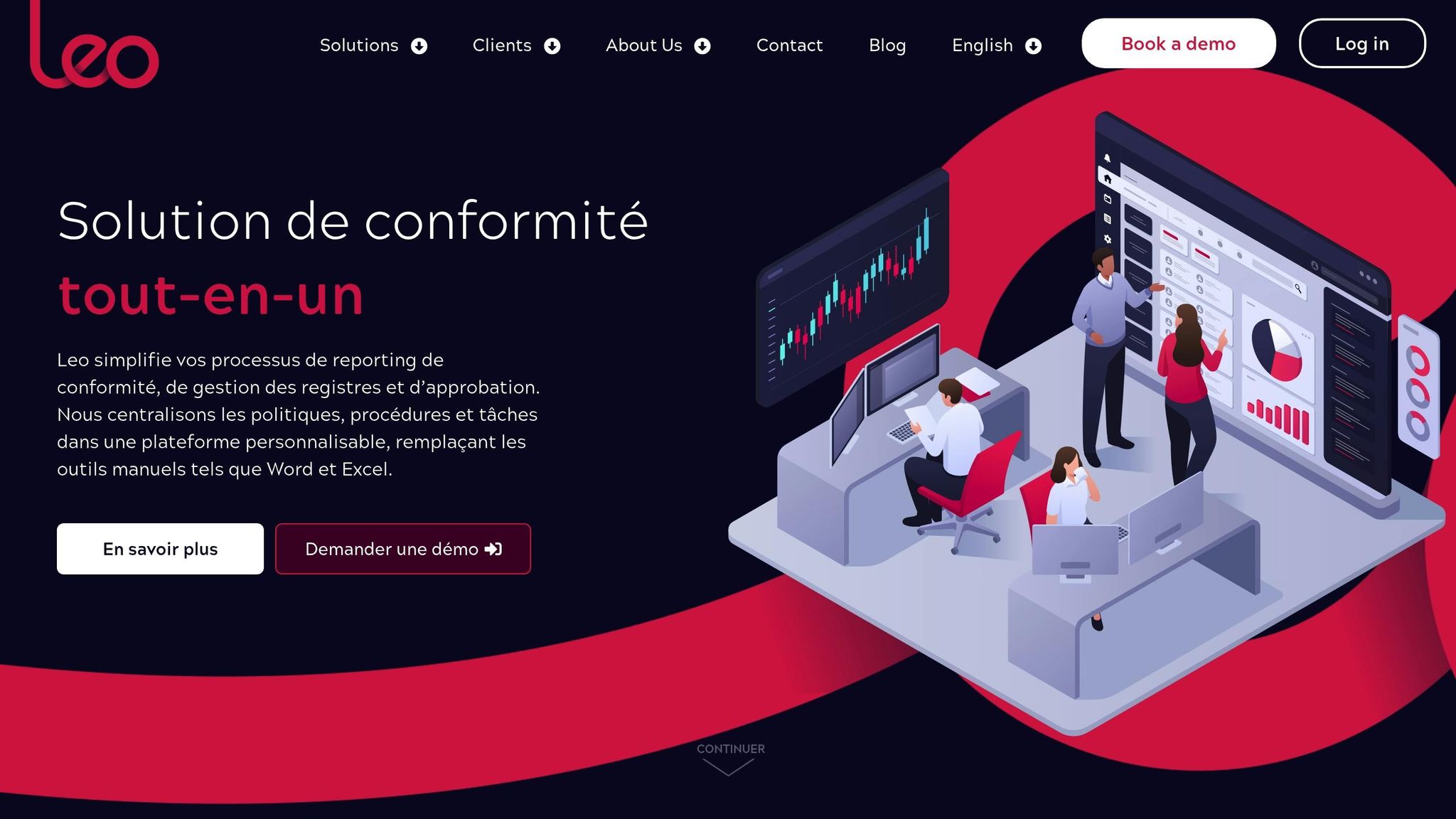
Leo RegTech delivers an AI-driven compliance platform tailored for financial institutions. It combines real-time regulatory monitoring with advanced AML and fraud detection tools, offering a practical solution for simplifying compliance tasks while managing costs. A standout feature is its AI assistant, Eva, which provides citation-supported answers, giving users added confidence in their compliance decisions.
Real-time Monitoring and Alerts
Leo RegTech keeps institutions updated on regulatory changes as they happen, ensuring they stay ahead of evolving requirements. The platform offers proactive, customized alerts, designed to address specific institutional needs.
"The regulatory content in Leo is kept up-to-date by Leo's diligent team and compliance partners who add and amend information requirements ahead of time. Your compliance platform will always be ready with current information."
One of its key strengths is the reduction of false positives - by as much as 60% - through AI-powered search and analysis tools. The platform’s AI assistant, Eva, enhances the experience by delivering context-rich, citation-backed answers to compliance-related questions. Eva is specifically trained on UK regulations, fund operations, and the Leo platform itself, making it a valuable resource for users.
Fraud Detection and AML Capabilities
Leo RegTech integrates essential compliance tools like Client Due Diligence (CDD), which includes KYC processes, AML screening, ID/address verification, and fake document detection. It also offers configurable questionnaires and online training modules to simplify compliance workflows. AML screening features cover background checks, sanctions screening, and Politically Exposed Persons (PEPs) reviews, using data from global sources.
The platform compiles KYC data into unified reports, streamlining the compliance process. Additionally, its training modules help staff stay informed on AML and other compliance topics. For example, Trade Nation, a financial services firm, has leveraged Leo RegTech’s training tools to improve its operations:
"We mainly use the training courses, to which access is provided to all of our staff. It's very easy to allocate courses to members of staff, and being able to send multiple relevant courses to different employees has been one of the biggest time savers." – Anthony Sharpe, Chief Strategy Officer, Trade Nation
Integration with Financial Platforms
Leo RegTech integrates smoothly with existing core banking and transaction monitoring systems, avoiding the need for costly system overhauls. Its modular and highly configurable design allows institutions to adopt only the features they require, with customizable workflows, templates, and reports that align with their internal policies and regulatory obligations.
Building on integration capabilities seen in platforms like Compliance.ai, Kount, and SAS, Leo RegTech references existing institutional data - such as personal account trade requests and staff gifts registers - eliminating duplicate data entry and ensuring consistency across compliance processes.
Pricing Structure and Scalability
While specific pricing details aren’t disclosed, the platform’s modular design ensures it can scale to meet the needs of both small firms and large institutions. The reduction in false positives - up to 60% - translates directly into cost savings by freeing up analysts from investigating unnecessary alerts. Additionally, its online training capabilities contribute to increased efficiency, with companies often experiencing a 30% boost in productivity when adopting e-learning solutions. This flexible, cost-conscious approach makes Leo RegTech a practical choice for institutions of all sizes, particularly those navigating complex regulatory landscapes.
Feature and Pricing Comparison
Choosing the right AI compliance solution requires a close look at both features and costs. Financial institutions must weigh their specific needs against their budgets to ensure they select a tool that aligns with evolving regulatory requirements.
| Solution | Core Features | Pricing Range | Key Integrations | Main Strengths |
|---|---|---|---|---|
| Compliance.ai | Regulatory change management, AI-powered document analysis, automated compliance tracking | $100,000 – $800,000 annually | Salesforce, Microsoft Teams, SharePoint, Slack, Google Workspace | Real-time regulatory updates, enterprise-wide integration |
| Kount (by Equifax) | Fraud detection, identity verification, risk scoring, transaction monitoring | $150,000 – $500,000 annually | Global watchlists, sanctions databases, PEP screening | Advanced fraud prevention, global data sources |
| SAS Compliance Solutions | Predictive analytics, risk assessment, regulatory reporting, AML monitoring | $500,000 – $2,000,000+ annually | SAS Viya platform, banking systems, insurance platforms | Deep analytics capabilities, industry-specific customization |
| Hawk:AI | Transaction monitoring, behavioral analytics, case management, explainable AI | $200,000 – $600,000 annually | Core banking systems, existing monitoring platforms | Explainable AI decisions, reduced false positives |
| Leo RegTech | Real-time monitoring, AML screening, compliance training, AI assistant (Eva) | $75,000 – $400,000 annually | Core banking systems, transaction monitoring, existing workflows | Cost-effective solution, 60% reduction in false positives |
This table provides a snapshot of the key features, pricing, and strengths of various AI compliance tools. Now, let’s dive deeper into pricing trends, integration efficiency, and scalability considerations.
Pricing and Total Cost of Ownership
The cost of AI compliance tools can vary significantly based on the level of sophistication and features offered. Basic solutions typically fall between $50,000 and $150,000, while enterprise-grade systems can climb to $2 million or more annually. For fraud detection and risk modeling tools, pricing generally ranges from $100,000 to $800,000.
However, the sticker price is only part of the story. Annual maintenance fees can add $5,000 to $20,000 or more, and staffing costs for specialized AI roles - such as engineers ($150,000–$250,000) and architects ($180,000–$300,000) - can significantly increase total expenses.
Integration and Scalability
Integration capabilities often define the long-term usability of these tools. Compliance.ai, for instance, integrates seamlessly with platforms like Salesforce, Microsoft Teams, and Google Workspace. SAS Compliance Solutions, on the other hand, leverages its Viya platform to connect with banking and insurance systems, making it a versatile choice for industry-specific needs.
Scalability is another critical factor. Leo RegTech offers a modular design, allowing institutions to start small and expand as needed. In contrast, enterprise-level solutions like SAS are designed to handle massive data volumes right from the start. This flexibility helps institutions manage costs while addressing their immediate and future compliance needs.
ROI and Adoption Trends
Solutions like Leo RegTech, which boasts a 60% reduction in false positives, and Hawk:AI, known for its explainable AI outputs, can deliver immediate returns on investment. Pre-built tools often come with lower upfront costs, while custom solutions provide greater flexibility but at a higher initial price.
With 63% of organizations already investing in AI, early adoption is proving to be a competitive advantage. AI spending is growing at an impressive 75.2% year-over-year, reflecting the increasing trust and reliance on these technologies.
Understanding pricing models, integration capabilities, and scalability options is crucial for financial institutions looking to implement an AI compliance solution that meets both current and future demands.
Conclusion
AI is reshaping compliance by automating tedious tasks, slashing manual document handling times by as much as 72%, and enabling real-time tracking of massive transactional data sets. With global AI spending projected to surpass $500 billion within the next two years, adopting these technologies is becoming increasingly unavoidable.
The move from traditional compliance methods to AI-powered systems directly tackles some of the industry's most pressing challenges. As Leslie Watson-Stracener, Managing Director and Regulatory Compliance Capability Leader at Grant Thornton Advisors LLC, puts it:
"The pressure and cost to comply with regulations on a bank's compliance management system and team can lead to stress, burnout and human error."
AI-driven tools are helping banks stay aligned with ever-changing regulations at a much faster pace.
However, selecting the right AI solution requires careful consideration of several factors, including model risk management, data governance, customer privacy, supervisory controls, cybersecurity, vendor relationships, and workforce dynamics. To ensure success, organizations must implement strict data protocols, maintain detailed inventories, set clear performance benchmarks, uphold explainability standards, and incorporate human oversight. This structured approach equips institutions to navigate the rapidly evolving compliance landscape.
Beyond operational improvements, embracing AI offers tangible benefits, such as capturing an 18% share of the banking market for machine learning and achieving annual cost savings ranging from 1.5x to 4x. These figures highlight the importance of choosing tools that align with your regulatory requirements.
As discussed, a forward-thinking compliance strategy depends on leveraging both advanced technology and strong governance. With compliance demands intensifying and costs decreasing, AI is no longer a luxury - it's a necessity. By thoroughly evaluating your business model and building a solid governance framework, you can ensure your AI adoption addresses regulatory challenges effectively, keeping your organization competitive in a constantly changing market.
FAQs
How can AI tools help reduce false positives in financial compliance, and why does it matter?
AI tools play a key role in cutting down false positives in financial compliance by examining transaction patterns, customer behavior, and using real-time risk scoring. They adjust alert thresholds and focus on genuine risks, which makes compliance monitoring much more precise.
Why does this matter? Fewer false positives lead to lower operational costs, less time wasted on chasing irrelevant alerts, and more attention on actual threats. By simplifying compliance workflows, AI helps financial institutions stay on top of regulatory requirements in a much more efficient way.
What should financial institutions look for in an AI compliance solution?
When choosing an AI compliance solution, financial institutions should focus on tools that prioritize transparency and explainability in AI decision-making. These features are crucial for meeting regulatory standards. Equally important is selecting a platform that safeguards data privacy and security while offering strong risk management capabilities to address potential risks tied to AI models.
Consider solutions that include features like automated compliance reporting, real-time risk detection, and policy violation alerts to simplify regulatory processes. It's also important that the platform supports continuous monitoring and adheres to legal requirements, ensuring both compliance and operational reliability.
How do AI compliance tools work with financial systems, and what are the key benefits?
AI compliance tools work hand-in-hand with financial systems by automating workflows, offering real-time data analysis, and facilitating smooth data exchange. These tools take the hassle out of compliance tasks like monitoring, reporting, and managing risks, cutting down on manual work and reducing the chances of human error.
Here’s what makes them stand out:
- Greater accuracy: AI can spot risks and inconsistencies more effectively, ensuring adherence to global standards.
- Boosted efficiency: Automation frees up time and resources, letting teams concentrate on more strategic, high-impact work.
- Lower costs: With less need for manual oversight, AI tools help trim operational expenses while delivering reliable compliance results.
By integrating these tools, financial institutions can not only keep up with regulatory demands but also improve their overall performance and dependability.
Related Posts
AI in Financial Planning: Benefits for SMBs
Explore how AI tools transform financial planning for SMBs, enhancing efficiency, reducing costs, and providing real-time insights for smarter decisions.
AI Compliance Automation: 2024 Guide
Explore the benefits, technologies, use cases, and best practices of AI compliance automation in this comprehensive guide. Learn how AI is transforming regulatory compliance.
